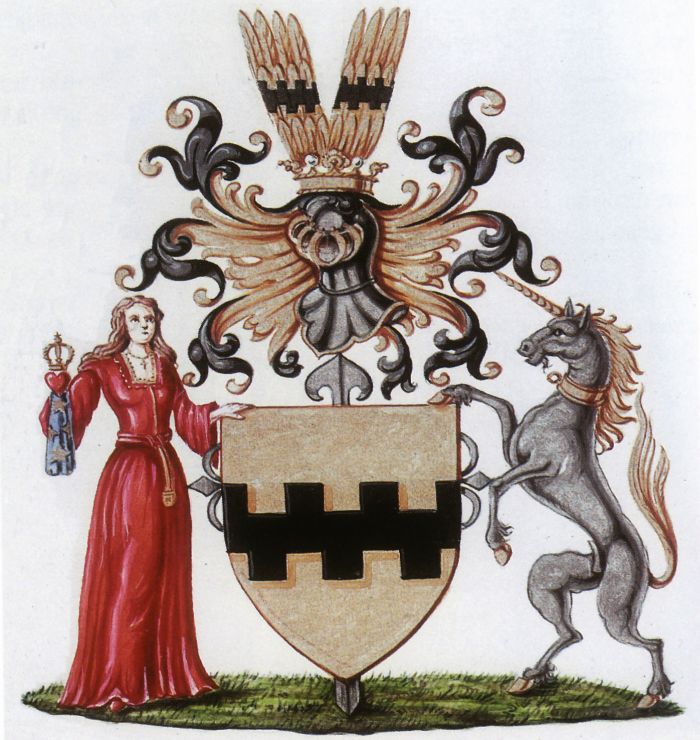Jette: Difference between revisions
Knorrepoes (talk | contribs) No edit summary |
Knorrepoes (talk | contribs) |
||
| Line 20: | Line 20: | ||
The first arms were granted on May 10, 1841, but were replaced on January 29, 1953 by the above arms. | The first arms were granted on May 10, 1841, but were replaced on January 29, 1953 by the above arms. | ||
The old arms showed the image of the local patron saint, St. Peter (see below). | The old arms showed the image of the local patron saint, St. Peter (see below). The colours are the Dutch national colours, as in 1813 the mayor applied without indicating the colours. The arms were thus granted in the national colours. When the arms were confirmed after the Belgian independence, the colours were not changed. | ||
The present arms are the arms of the Van Kinschot family. These were Lords of the manor of Jette in the 16th-18<sup>th</sup> century. Their arms also appeared on the local seal dating from the 16<sup>th</sup> century. | The present arms are the arms of the Van Kinschot family. These were Lords of the manor of Jette in the 16th-18<sup>th</sup> century. Their arms also appeared on the local seal dating from the 16<sup>th</sup> century. | ||
Revision as of 12:23, 24 January 2015
| Heraldry of the World Civic heraldry of Belgium - Belgische Gemeentewapens / Armorial de Belgique |
JETTE
Province : Stadsgewest Brussel / Région Bruxelles
Official blazon
- (1841 nl) Een blaeuw veld met het gulden beeld van Sint Peter.
- (1841 fr) D'azur à un Saint Pierre d'or.
- (1953 nl) Van goud met een gekanteelde en tegen-gekanteelde faas van sabel, het schild getopt met een helm van zilver, getralied, omboord en gekroond van goud met dekkleden van goud en van sabel. Helmteken: een antieke vlucht van goud, elke vleugel beladen met een gekanteelde en tegengekanteelde faas van sabel - het schild geplaatst op een degen van de Ridders der Orde van Sint Jacob, rechts gehouden door een dame van vleeskleur gekleed van keel, de linkerhand rustend op het schild en in de rechterhand een hart van vleeskleur houdende, geplaatst op een sluier van azuur, bezaaid met sterren van gouden overtopt met een koninklijke kroon van hetzelfde en links gehouden door een eenhoorn van zilver, gehoornd, genageld, gehalsband en met manen van goud.
- (1953 fr) D'or à la fasce bretessée et contrabretessée de sable, l'écu sommé d'un heaume d'ergent grillé liseré et couronné d'or, aux lambrequins d'or et de sable. Cimier: un vol à l'antique d'or, chaque aile chargée d'un fasce bretessée et contrabretessée de sable - l'écu posé sur une épée des Chevaliers de l'Ordre de Saint Jacques, et tenu à dextre par une dame de carnation vêtue de gueules ayant la main senestre sur l'écu et tenant de la dextre un coeur de carnation posé sur un voile d'azur semé d'étoiles d'or et surmonté d'une couronne royale du même et supporté à senestre par une licorne d'argent accornée, onglée, accolée et crinée d'or.
Origin/meaning
The first arms were granted on May 10, 1841, but were replaced on January 29, 1953 by the above arms.
The old arms showed the image of the local patron saint, St. Peter (see below). The colours are the Dutch national colours, as in 1813 the mayor applied without indicating the colours. The arms were thus granted in the national colours. When the arms were confirmed after the Belgian independence, the colours were not changed.
The present arms are the arms of the Van Kinschot family. These were Lords of the manor of Jette in the 16th-18th century. Their arms also appeared on the local seal dating from the 16th century.
| The arms in the Koffie Hag/Café Hag albums +/- 1930 |
Contact and Support
Partners:
Your logo here ?
Contact us
© since 1995, Heraldry of the World, Ralf Hartemink 
Index of the site
Literature : Servais, 1955












